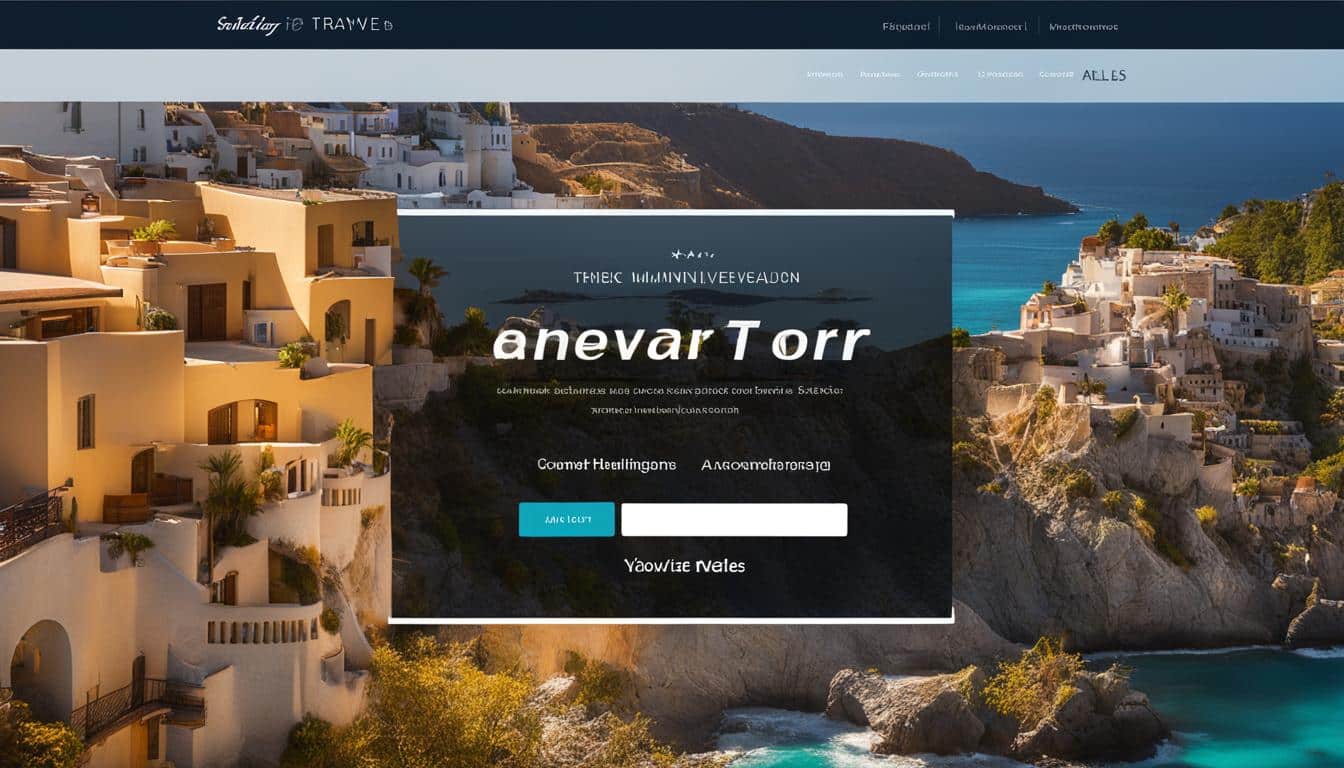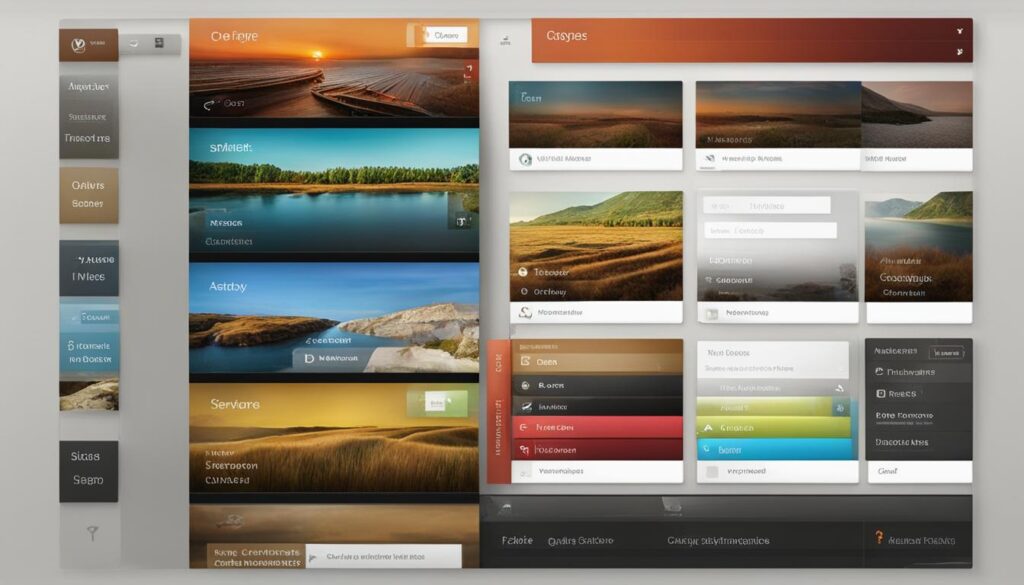
When it comes to running a successful travel website, optimizing the layout is key. A well-designed and user-friendly website can greatly enhance the user experience, improve conversion rates, and boost your search engine ranking. In this article, I will share expert insights and tips on how to optimize your travel website layout for maximum impact.
Creating a visually appealing travel website with easy navigation is crucial. A responsive and mobile-friendly design ensures that your website looks great and functions well on all devices, providing a seamless experience for users. Additionally, integrating SEO-friendly elements into your website layout can improve its visibility and organic traffic.
Whether you're revamping an existing travel website or starting from scratch, there are several key considerations to keep in mind. From choosing the right travel website layout to implementing user-friendly features, this article will provide you with the knowledge and insights you need to optimize your travel website and attract more visitors.
Key Takeaways:
- Design a user-friendly travel website layout that prioritizes easy navigation and a visually appealing design.
- Ensure your travel website is responsive and mobile-friendly to cater to the increasing number of mobile users.
- Optimize your website for speed to improve user experience and search engine ranking.
- Consider user intent when designing your navigation bar to provide a personalized and intuitive browsing experience.
- Implement SEO strategies in your travel website layout to improve visibility and attract organic traffic.
Understanding User Intent and Designing a User-Friendly Navigation Bar
When designing a travel website, it is crucial to understand the intent of the users and tailor the website experience to meet their needs. User intent refers to the reason behind a user's search or visit to a website. By categorizing users into different groups based on their intent – informational, educational, and transactional – you can design a user-friendly navigation bar that guides them to the relevant information or products.
Analyzing user flow and using tools like Google Analytics can provide valuable insights into how users navigate your travel website. This information can help identify any issues or roadblocks that users may encounter. By organizing the navigation bar based on user intent or using a product-centric approach, you can streamline the user journey and make it easier for them to find what they are looking for. However, it is important to strike a balance and not overwhelm users with too many categories. Keep the wording clear and concise, using action-oriented links on the right side of the navigation bar for better visibility and accessibility.
When it comes to user-friendly navigation bar design, conventional navigation practices are often the most effective. Users are accustomed to certain navigation patterns and expect to find certain elements in specific places. By adhering to these conventions, you can create a seamless user experience and reduce the learning curve for new visitors. Additionally, implementing a clear content hierarchy will help users navigate your travel website effortlessly, ensuring that important information is easily discoverable.
Key Takeaways:
- Understanding user intent is crucial for designing a user-friendly travel website.
- Categorize users into groups based on their intent – informational, educational, and transactional.
- Analyze user flow and use tools like Google Analytics to identify navigation issues.
- Organize the navigation bar based on user intent or a product-centric approach.
- Stick to conventional navigation practices to create a seamless user experience.
- Implement a clear content hierarchy for easy navigation and discovery of important information.

Table: User Intent and Navigation Bar Categories
| User Intent | Navigation Bar Categories |
|---|---|
| Informational Users | About Us, Destination Guides, Travel Tips |
| Educational Users | Travel Courses, How-to Guides, Travel Resources |
| Transactional Users | Flights, Hotels, Car Rentals, Packages |
By aligning your travel website's navigation bar with the different user intents, you can provide a personalized and user-friendly experience. Remember to regularly analyze user data and make adjustments to optimize navigation based on user behavior and feedback. A well-designed navigation bar will enhance the overall usability of your travel website and increase visitor engagement and conversions.
Importance of Mobile Optimization and Page Speed
With the increasing use of mobile devices for browsing the internet, mobile optimization has become crucial for travel websites. It is essential to ensure that your website is mobile-friendly and provides a seamless user experience across different screen sizes. A mobile-friendly test can help identify any issues and ensure that your website loads correctly and quickly on mobile devices. Mobile optimization not only enhances user experience but also plays a significant role in search engine rankings.
Page speed is another critical factor that can greatly impact the success of your travel website. Users expect websites to load quickly, and a slow-loading site can lead to frustration and high bounce rates. Moreover, page speed is a ranking factor that search engines take into account when determining the position of your website in search results. Therefore, optimizing your website for faster page speeds is essential for both user satisfaction and SEO.
There are several strategies you can implement to improve mobile optimization and page speed. Compressing code, leveraging browser caching, and optimizing images are effective ways to reduce page load time. Additionally, utilizing content delivery networks (CDNs) can distribute your website's content across multiple servers, further improving performance. By prioritizing mobile optimization and page speed, you can provide a seamless user experience and improve the overall performance of your travel website.
| Mobile Optimization Strategies | Page Speed Optimization Techniques |
|---|---|
| 1. Implement responsive web design | 1. Compress code to reduce file size |
| 2. Optimize images for mobile | 2. Leverage browser caching |
| 3. Prioritize content visibility on small screens | 3. Utilize content delivery networks (CDNs) |
| 4. Use mobile-friendly typography | 4. Minify CSS and JavaScript files |
| 5. Test website performance on different devices | 5. Optimize image loading and rendering |
Conclusion
In conclusion, optimizing a travel website layout is a crucial step in improving user experience and overall website performance. By prioritizing user-friendly design, mobile optimization, and fast page speed, travel websites can attract more visitors and enhance their SEO ranking.
Understanding user intent and designing a user-friendly navigation bar based on different user categories (informational, educational, and transactional) can significantly improve the usability of the website. By organizing the navigation bar effectively and using clear and concise wording, users can easily find the information or products they are looking for.
Mobile optimization is essential in today's world, considering the majority of website traffic comes from mobile devices. Ensuring that the travel website is mobile-friendly and loads quickly on different screen sizes can enhance user experience and boost SEO ranking. Additionally, optimizing page speed by compressing code, utilizing content delivery networks (CDNs), leveraging browser caching, and optimizing images can further improve website performance.
By implementing these website optimization strategies, travel websites can create a visually appealing, user-friendly, and efficient platform. This will not only attract more visitors but also improve conversions and ultimately lead to a successful travel website.
FAQ
What is website optimization and why is it important for a travel website?
Website optimization involves improving various aspects of a website to enhance user experience, increase website speed, mobile-friendliness, accessibility, and improve search engine ranking. It is important for a travel website as it can attract more visitors, improve conversions, and enhance overall website performance.
How can I optimize the user interface (UI) and user experience (UX) of my travel website?
To optimize the UI and UX of your travel website, focus on user-friendly design, mobile responsiveness, and better accessibility. This can be done by designing a visually appealing and easy-to-navigate layout, ensuring mobile compatibility, and providing accessible features such as alt text for images and proper heading structure.
How can I categorize users based on their intent and tailor the website experience to their needs?
Categorizing users into different groups based on their intent (informational, educational, and transactional) can help tailor the website experience. Analyzing user flow and using tools like Google Analytics can provide insights into how users navigate the site, allowing you to identify any issues and organize the navigation bar based on user intent or product-centric approaches.
How can I optimize my travel website for mobile devices?
Optimizing your travel website for mobile devices is essential since the majority of website traffic comes from mobile devices. Run a mobile-friendly test and ensure that the site loads quickly and correctly on different screen sizes. Optimize page speed by compressing code, utilizing content delivery networks (CDNs), leveraging browser caching, and optimizing images for a seamless user experience and improved SEO ranking.
What are the benefits of optimizing the page speed of my travel website?
Optimizing page speed not only improves user satisfaction but also enhances SEO ranking. Fast-loading websites provide a better user experience, leading to higher conversion rates. By compressing code, utilizing CDNs, leveraging browser caching, and optimizing images, you can significantly improve website performance and attract more visitors to your travel website.











